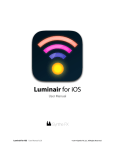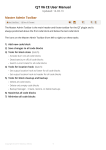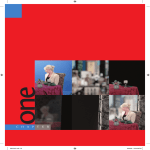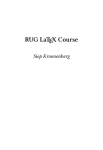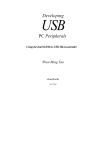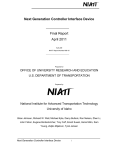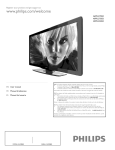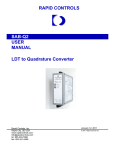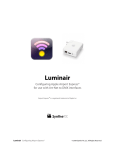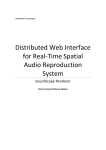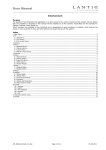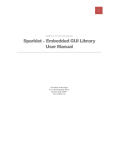Download Luminair iPad 2.0 User Manual
Transcript
Luminair for iPad User Manual Luminair for iPad User Manual v2 © 2012 Synthe FX, LLC. All Rights Reserved Welcome Thank you for purchasing Luminair for iPad! Luminair is revolutionary lighting control software that allows you wirelessly control, view & record snapshots from intelligent DMX lighting fixtures, dimmers, consoles, other software and media servers, all from your iPad. Using the Art-Net and sACN E1.31 protocols over your device’s built-in Wi-Fi connection, Luminair wirelessly communicates with other compatible hardware and software interfaces on your network. Use Luminair as the ultimate remote focus tool, for advanced architectural lighting, as a technicians tool, as a back up console, or simply as the centerpiece of your DMX lighting rig. With features such as Stacks playback and CoverFlow triggering, the creative possibilities are limitless. We at Synthe FX take great pride in creating professional tools that are both powerful and easy to use, and we are sure you will appreciate our attention to detail from the very first time you open the application. Luminair for iPad User Manual v2 © 2012 Synthe FX, LLC. All Rights Reserved Table Of Contents Setting Up 10 A word about Art-Net 10 A word about sACN E1.31 10 iPad Wi-Fi Configuration 10 Other Notes... 11 Running on battery 12 Interface Overview 13 App Toolbar 13 Main Menu 13 Track List (controls mode) 13 View Mode (controls mode) 13 CoverFlow (controls mode) 14 Input Universe 14 Output Mode 14 Add Menu (controls mode) 14 Actions Menu (controls mode) 14 Edit (controls mode) 14 Master Output 14 iCloud Support 15 Main Menu Options 16 Projects Project Selection View Luminair for iPad User Manual v2 16 16 © 2012 Synthe FX, LLC. All Rights Reserved Create A New Project 17 Duplicate Project 17 Lock Project 17 Rename Project 17 Delete Project 17 Share iCloud Link 17 Email Project 18 File Transfer 18 Settings 19 Node Name 19 Output FPS 19 Ignore Idle Timer 19 Display DMX Values 19 Auto-Patch New Tracks 19 Auto-Select New Cues 19 Auto-Save Projects 19 Default Hold Time 20 Stacks Live Selection 20 Controls Auto-Update 20 Fullscreen Lock Enabled 20 Fullscreen Lock Passcode 20 MIDI Input 20 OSC Input 20 Auto-Update Project Data (iCloud) 20 Luminair Extras Luminair for iPad User Manual v2 21 © 2012 Synthe FX, LLC. All Rights Reserved DMX Signal Monitor 22 DMX Signal Views 22 Channels Overview 22 Channel Details View 22 External Monitor (AirPlay) Controls Mode 23 24 Mixer View 25 List View 25 Cue options 27 Activating/De-activating Cues 27 Editing Cue Settings 27 Lock/Unlock (Editable Cues) 27 HTP Merge (Merge Cues) 27 Make Editable (Frozen Cues) 27 (Re-)Recording Input Data (Input Cues) 28 MIDI Learn 28 Action Menu 28 Undo 28 Disable All 28 Reset Tracks 28 Clear Cues 28 MIDI Learn 28 Track Detail View Touch-Enabled Fader Controls Luminair for iPad User Manual v2 29 29 © 2012 Synthe FX, LLC. All Rights Reserved Track Name 29 Track Blackout (BO) button 30 Track Solo (SO) button 30 Next/Previous Track buttons 30 Enable/Disable Master 30 Channel Editor 31 Enabling Channels 31 Action Menu 31 Previous & Next 31 Offset & Multiply 31 Channel Types 31 Setting Track type 33 Accelerometer (XY Controls) 35 Saving Fixture Presets 36 About Synthe FX Fixture Presets 36 CoverFlow 37 Stacks Mode 38 Action Button 38 Previous Stack 38 Previous Cue 38 Play Toggle 38 Next Cue 39 Next Stack 39 Loop Mode Button 39 Shuffle 39 Luminair for iPad User Manual v2 © 2012 Synthe FX, LLC. All Rights Reserved Batch Timing 39 Show Current Playing Stack 39 Status Status View 41 41 Network 41 Connection 41 IP Address 41 Subnet Mask 41 MAC Address 42 Art-Net 42 Node Enabled 42 Node 42 Subnet 42 Input Universe 42 Output Universe 42 sACN 42 Node Enabled 42 Output Universe 42 MIDI 42 Interface 42 MIDI Network 42 MIDI Input MIDI Learn (controls) Learnable commands Luminair for iPad User Manual v2 43 43 45 © 2012 Synthe FX, LLC. All Rights Reserved Toggle MIDI Learn 45 Controls Mode 45 Stacks Mode 45 CoverFlow Mode 45 Playback Toggle 45 Play 45 Stop 45 Next 45 Previous 45 Go To Start 45 Play Mode Toggle (Stacks) 45 Shuffle Stack 45 Next Stack 45 Previous Stack 45 Master Blackout 46 Master Level Fader 46 Enable All Tracks 46 Disable All Tracks 46 Mixer View Scroll 46 Cue Selection Scrub 46 MIDI Show Control (in-app purchase only) OSC Input OSC Settings Support Luminair for iPad User Manual v2 47 49 49 54 © 2012 Synthe FX, LLC. All Rights Reserved For email and online FAQ based support Luminair for iPad User Manual v2 54 © 2012 Synthe FX, LLC. All Rights Reserved 10 Setting Up A word about Art-Net Art-Net is a protocol developed by Artistic Licence, that allows for transmission of DMX data over a network, and it is compatible with numerous existing DMX consoles, lighting devices, and other hardware and software. In an Art-Net network, all devices on the network are called “nodes”. A node can be a DMX control console, a hardware Art-Net to DMX converter interface, a lighting fixture, or even DMX control software. Each of these Nodes can communicate with each other over the local network. Luminair itself is an Art-Net node that both receives and all transmits DMX data. For more information about Art-Net network configuration, check out the Artistic Licence web site at http://www.artisticlicence.com A word about sACN E1.31 Luminair now supports outputting DMX over Wi-Fi via Streaming ACN, also known as sACN , or E1.31. sACN is a protocol developed by the PLASA Control Protocols Working Group and was eventually approved as an ANSI standard, just like DMX. http://tsp.plasa.org/tsp/working_groups/cp.html sACN presents an easy and powerful way of integrating Luminair with existing consoles, or in situations where you want to use multiple controllers on the same universe. Luminair can output to both Art-Net and sACN at the same time, however you will get better battery performance when picking one over the other. iPad Wi-Fi Configuration Important Network Setup Information Setting the proper Wi-Fi settings on your iPad will depend on how the Art-Net or sACN interfaces on your network are configured. Your iPad and Art-Net or sACN interface(s) must have an IP address in the same range, such as 192.168.0.x (where x is a number between 1 and 254). No two devices on an Ethernet network can use the same IP address at the same time. Additionally, your iPad and Art-Net or sACN interface must use the exact same subnet mask. The typical subnet mask for the 192.168.0.x range is 255.255.255.0. The default IP address on your Art-Net or sACN interface will vary, depending on the manufacturer. Enttec ODE interfaces, for example, ship with a IP address assigned in the 10.X.X.X range. In that case you would want to assign your iPad an address in that same range. Note: the Art-Net protocol requires a IP in the 10.X.X.X or 2.X.X.X range with a subnet mask of 255.0.0.0 Luminair for iPad User Manual v2 © 2012 Synthe FX, LLC. All Rights Reserved 11 To begin, from your devices Home screen, open Settings, then Wi-Fi. Select your Wi-Fi network from the list, under Choose a Network . If not listed here, you may need to add it by clicking Other, and entering the required information. In your network’s configuration screen, select Static. Now enter a unique IP Address and Subnet Mask in the range of your Art-Net or sACN interface(s). Finally, add your router’s IP Address, which is crucial for letting your device know it is actually connected to a Wi-Fi network. See the screenshot on the following page to confirm your settings are properly entered. Note: Although Luminair will work on any local network, we recommend using a dedicated Wi-Fi router or access point for your Art-Net or sACN network. Once the network settings are applied to a specific Wi-Fi network, they will stay configured until changed within the devices Settings app. This makes changing network settings on your device as simple as selecting the desired network from the Wi-Fi choices in the Settings app. Device Network Configuration Other Notes... * Luminair will only transmit or receive data on a local Wi-Fi network. Communications are disabled when transferring to a cellular data network. You will be properly notified if at any time Luminair can’t initiate a Wi-Fi network connection. * Please note, a working knowledge of computer networking is recommended before using this application. Synthe FX does not provide support beyond basic operation of Luminair, and can’t possibly troubleshoot each and every network configuration out there. If in doubt, please hire a professional consultant to properly configure your network. Luminair for iPad User Manual v2 © 2012 Synthe FX, LLC. All Rights Reserved 12 Running on battery Luminair was created to use as little battery power as possible during operation. Due to the way the iPad is designed, for power-saving reasons, the devices Wi-Fi signal is dropped whenever the device is locked. Developers unfortunately do not have control over this. When operating Luminair while your device is being powered by the internal battery, you must keep the screen ON and in an unlocked position to reliably send a signal from Luminair. When connected to a power source via the device’s dock connection, either a AC adapter or an external battery, Luminair will continue to playback Stacks even with the screen OFF and locked. Our tests have clocked in continuous Stacks playback on a 1st-generation iPad at up to 10 hours. Actual results will vary depending on a variety of factors such as Stack complexity, battery age, etc. Luminair for iPad User Manual v2 © 2012 Synthe FX, LLC. All Rights Reserved 13 Interface Overview Below is a brief description of the key areas of Luminair’s interface, as outlined in the following screenshot. App Toolbar This is where you select which master function you would like to view and/or control. The different functions are outlined below. Main Menu This is the applications main menu. Use it to open/save files, to set application preferences, and to access the user manual from within the application. Track List (controls mode) Select to view/analyze incoming data. View Mode (controls mode) Select to control/send output data. Luminair for iPad User Manual v2 © 2012 Synthe FX, LLC. All Rights Reserved 14 CoverFlow (controls mode) Enters CoverFlow mode for visually triggering cues. Input Universe Select to view/analyze incoming data and record DMX snapshots Output Mode This sets the app’s current output mode. Luminair has two main output modes, Controls and Stacks. Choose the left button to go into Controls mode to manipulate the levels in your universe, and the button on the right to go into Stacks playback mode. Add Menu (controls mode) Select to add a new control Track, Group, or Cue to your project. Actions Menu (controls mode) Select to perform batch functions Edit (controls mode) Select to delete or rearrange data in your project. Master Output This option displays a fader control that allows you to adjust the master level percentage of Luminair’s DMX output. This control is global, and is not currently saved in individual cues, except when using the cue “freeze” function (described in Cue options in this manual). Master Blackout Selecting this will send a value of 0 to all channels in your project when enabled. Status Select to view information pertaining the current network status of your Luminair node. The icon displayed in the tab bar will be displayed green if the node is enabled and a connection is present, and red if the node is disabled or if there is a connection error. Luminair for iPad User Manual v2 © 2012 Synthe FX, LLC. All Rights Reserved 15 iCloud Support Luminair for iPad v2 supports storage of all related files through iCloud. This means that you can seamlessly sync Luminair projects, fixtures, images, PDF documents, and MIDI maps between multiple iPads. To turn iCloud storage on or off, first make sure to turn iCloud documents support in your iPad’s Settings->iCloud. Then tap the iCloud icon button in the toolbar in Luminair’s project selection view. In Luminair’s projects viewer any files not yet downloaded from iCloud will be designated with a small cloud icon next to the name label. If you do not see the cloud icon, this project has been saved on your local device. Note: When enabling iCloud, Luminair will move all of your project, fixture, image and other document files into iCloud. These files will be synced between all of your iPad devices. Any conflicting files already in stored iCloud will be replaced with those on this device. When disabling iCloud, Luminair will copy all locally edited projects and other documents, plus all fixtures and images back onto your local device. The original files will remain in iCloud. Luminair for iPad User Manual v2 © 2012 Synthe FX, LLC. All Rights Reserved 16 Main Menu Options After opening Luminair for the first time, or selecting Main in the application tab bar, you are presented with the screen below. This is considered the application’s main view, and is where global application options are set. The user manual can be accessed directly from this view’s toolbar. Main Menu Projects Luminair has it’s own file format for saving and restoring “Project” files. Projects are saved with a .luminair file extension, and can be previewed and opened from Luminair’s project selection view. When opened, Projects are saved periodically in the background, without user intervention. Project Selection View To open Luminair’s project selection view when you already have an existing project open, press the Projects selection in Luminair’s Main menu. The view will then zoom out to reveal the project selection view, which is a scrolling display of preview images of all of your Luminair Projects. Swipe left or right to browse through the selections, then tap a project to open, Luminair for iPad User Manual v2 © 2012 Synthe FX, LLC. All Rights Reserved 17 Luminair’s Project Selection View Create A New Project To create a new Luminair project file, tap on the Duplicate Project To duplicate the selected project, tap on the copy will be added to Luminair project library. Lock Project To lock a Luminair project, tap on the button and select New Project File. button and select Duplicate project. A button and select Lock Project. Rename Project To rename a Luminair project, tap on the button and select Rename. A textfield will appear where you can type a new name for this project file. Delete Project To delete the selected project file, tap on the button and select Delete Project. Share iCloud Link When iCloud storage is enabled, you can email a direct link to the selected project’s project file, which is accessible via any modern web browser. Tap on the button and select Share iCloud Link. Luminair for iPad User Manual v2 © 2012 Synthe FX, LLC. All Rights Reserved 18 Email Project To send the selected project file as an attachment via email, tap on the button and select Email Project. Note that when iCloud is enabled, only locally edited documents can be sent via email. Use the “Share iCloud Link” option for files that aren’t locally stored. File Transfer To transfer files back and forth between your iPad and Mac or PC, tap on the and select File Transfer. See the section on File Transfer below for more details. button File Transfer Users have multiple options for transferring project and fixture files between their device and a host computer, allowing them to backup, load, and/or share files between multiple devices. Luminair includes an embedded HTTP web server, which can be accessed via any webbrowser, on any computer platform. Users have the ability to both upload and download files over the local network through this web server. In addition, Synthe FX provides LCompanion, a Mac desktop utility application for file transfers. This application is available on the Mac App Store as a free download, and is compatible with Mac® OS X 10.6.5 Snow Leopard and above. Other major benefits of LCompanion are the ability to quickly create custom fixture preset files, and also output DMX from Luminair to select USB DMX interfaces connected to your Mac. Tap the “Start Server” button to enable File Transfer mode. Once the server is started, Luminair is in File Transfer mode, and can be accessed by computers on the same network. Luminair will be accessible via a web browser, both with the devices current IP address(http:// xx.xx.xx.xx:8080), and also with the devices Bonjour host name (http://devicename.local: 8080). If using LCompanion, the device will also be displayed in the main device list. The server username is always Luminair when connecting via a web browser. The server password, by default, is a 4-digit code that is randomly changed every time the server is started. This code is displayed in the password field, and can be customized simply by entering the desired password into the field. Important The most important part of setting up your device for file transfers is making sure your device and computer are on the same basic network subnet. This might be different from the specialized network settings you entered for Luminair to communicate with other Art-Net or sACN interfaces on the network. Selecting DCHP in your iPad network settings, and also on your computer’s network setting is the easiest way to make sure they are on the same basic network subnet. Important When transferring project files to your computer, please make sure you download any image reference files associated with the project as well. These are stored separate, and referenced from project files. Luminair for iPad User Manual v2 © 2012 Synthe FX, LLC. All Rights Reserved 19 Settings Luminair allows the user to specify settings, which allow you to configure the ArtNet node for your implementation. These preferences are automatically saved when closing the app, and restored when opening the application. All changes are made in realtime. Below is a description of what these preferences control. Node Name This is where the Art-Net node name is set. The default name is Luminair, however you may choose to set this to another name to further distinguish your device on your network. Output FPS This controls the output frame rate of the data being output by Luminair. Setting this to a lower frame rate can save battery power on your device. If Luminair is in low power mode, it only outputs at the designated frame rate when changes have been made to the output data. Otherwise data is output at a rate of 0.5 frames per second. Low Power Mode Selecting low power mode makes Luminair run in a way that helps conserve battery power on your device. Data is only output when necessary, and uses a variable frame rate for outputting data to conserve battery life, where it only outputs the designated frame rate when changes have been made to the output data. This option is turned ON by default. Ignore Idle Timer Turning this option on will turn off the application’s sleep timer, preventing the screen from going to sleep. Display DMX Values Turning this option on will make output tracks display the actual DMX values. Otherwise, Luminair will display values as percentages. This option is turned ON by default. Auto-Patch New Tracks If this option is turned on, Luminair automatically patches channels to the first available channel when creating new tracks. When disabled, Luminair will create empty tracks. Auto-Select New Cues If this option is turned on, Luminair will automatically select and activate newly created cues. With this option turned off, Luminair will keep the current cue activated when creating new cues. Auto-Save Projects If this option is turned on, Luminair will periodically save the current project in the background automatically, without user intervention. Disabling auto-save can improve Luminair for iPad User Manual v2 © 2012 Synthe FX, LLC. All Rights Reserved 20 performance in large projects. Saves are always automatic when closing projects, and when putting Luminair into the background. Default Fade Time Set the default fade time to be applied to Cues when added. A time range of 0-20 seconds, configurable to the tenth of a second can be set here Default Hold Time Set the default hold time to be applied to Cues when added. A time range of 0-7 days, configurable to the tenth of a second can be set here. Stacks Live Selection Turning this option on will make Luminair output DMX when selecting cues in Stacks mode, even if playback is not currently enabled. Releasing all cues to black is accomplished by selecting the Stack reset button when this option is enabled. This option is turned ON by default. Controls Auto-Update Turning this option on will make Luminair update the controls in Mixer View when cues are selected in Stacks mode, effectively making them follow the current selection. Fullscreen Lock Enabled Turning this option on will lock Luminair’s user interface when in fullscreen CoverFlow mode. Make sure to set a passcode once this option has been turned on. Fullscreen Lock Passcode Please write down your code! Luminair will need to be deleted and reinstalled if you lose this passcode. Enter the passcode for fullscreen lock by selecting this option. Luminair uses a 4-digit code, which you must enter twice. MIDI Input Set options related to MIDI remote control. See Chapter on MIDI Input further in this user manual for complete details. OSC Input Set options related to OSC remote control. See Chapter on OSC Input further in this user manual for complete details. Auto-Update Project Data (iCloud) When this option is turned on, Luminair will automatically resolve conflicts and update project data when it’s changed on another device through iCloud, rather than present a conflict resolution popup. Luminair for iPad User Manual v2 © 2012 Synthe FX, LLC. All Rights Reserved 21 Luminair Extras Luminair Extras is where users can buy specialized “add-ons” via iTunes In-App purchase, which add advanced functionality to the software for a variety of industry specific uses. Luminair Extras may also occasionally contain additional special offers for our users, and direct links to manufacturers of compatible hardware. To restore any of your previous In-App purchases made in a previous installation or on another device, tap the “Restore Purchases” button at the bottom of the Luminair Extras window. The App Store will verify your previous purchase and Luminair will install any necessary add-ons, free of charge. Note that Luminair Extras requires a connection to the internet to function. Luminair for iPad User Manual v2 © 2012 Synthe FX, LLC. All Rights Reserved 22 DMX Signal Monitor Luminair provides a simple to use interface for viewing and analyzing both output and input DMX data. Additionally, users now have the option of displaying DMX levels on an external HDTV or projector, wirelessly via AirPlay to an Apple TV or through the dock connector via HDMI, VGA, component or composite cable. Channels Overview Channel Details DMX Signal Views There are 2 primary views for analyzing input data, the Channels Overview, and the Channel Details view. Channels Overview This is an overview of all channels on the current input universe. Thirty channels at a time are viewable, and touching the arrow or touch-scroll controls allows you to scroll through all 512 channels. The current value for each channel is shown as a bar level in the corresponding box. By touching any of these channel boxes, the Channels Details view will be displayed for the selected channel. Channel Details View This is the view that show the current value for the selected channel. Furthermore, the past 24 seconds are displayed as a line graph for a greater detailed overview. To select the previous or next channel, touch the arrow controls. Luminair for iPad User Manual v2 © 2012 Synthe FX, LLC. All Rights Reserved 23 External Monitor (AirPlay) Luminair offer users a number of ways to monitor DMX signal on an external HDTV or projector: - AirPlay via AppleTV - HDMI via Apple iOS Dock to HDMI Adapter - VGA via Apple iOS Dock to VGA Adapter - Component cable via Apple iOS Dock to Component Adapter - Composite cable via Apple iOS Dock to HDMI Adapter To activate AirPlay monitoring, first connect to your AppleTV via AirPlay and select “Mirror” in the iPad’s system dock (double-tap on the home button and swipe left to right). Luminair will then detect this as an external display, and you can tap the the external display icon in Luminair’s DMX signal view. To activate HDMI, VGA, Component, or Composite external display, first connect the appropriate dock accessory and open Luminair’s DMX Signal view popup. In this popups toolbar, tap the external display icon. Luminair for iPad User Manual v2 © 2012 Synthe FX, LLC. All Rights Reserved 24 Controls Mode Luminair offers a number of different controls and methods for manipulating and building DMX data. Controls mode is the first of the two main app output modes, the other being Stacks. Controls mode is where you configure your tracks and cues, and build your overall looks for your project. Use the Add Menu to begin adding tracks, groups of tracks and cues to your project. Tracks DMX channel layouts are represented as Tracks. A Track can either represent one lighting fixture or multiple fixtures, depending on the channel layout. See more info on setting these channel layouts, and the different possibilities, in the Channel Editor section further ahead in this chapter. A tracks output power value ranges from 0 to 255, unless specified as a specific range in the channel track type options. Luminair for iPad User Manual v2 © 2012 Synthe FX, LLC. All Rights Reserved 25 Luminair currently has three main track types to choose from, depending on the parameter in your lighting fixture you would like to control. Each of the different track types is explained in further detail on page 27 of this user manual. Luminair gives the user the option of working single tracks on their own, or with groups of tracks. Groups can be useful if the equipment you are controlling has a large channel count that you want full control of. Another option is creating tracks only for the features on your fixtures that you want to control, one at a time. The ability to address multiple channels types for each track makes this possible, and helps in keeping the interface and project information manageable on a small screen device. Each added track’s channel info is given priority over the previous track’s channel info. So if multiple tracks are assigned a channel type on the same channel, the priority is given to the bottom-most track in List View, or the track furthest to the right in Mixer View. Mixer View This upper portion of the Controls View, this view emulates a physical lighting board with multi-touch enabled fader controls. XY Controls are also easily accessible from this view as well. This view is scrollable by swiping your finger either to the left or right, anywhere outside of the mixer controls. Tracks can be selected by double tapping on the track’s name label. The value label below each track’s fader control displays the values or percentages being output. If this is an XY control (fine) track, the value will be displayed as the rough component for screen space-saving reasons. Pressing the value label on each track will let you edit the track with a traditional keypad. Double tapping between any two related “group” tracks will filter the view to display only the specific group. From this view, by tapping the options icon in the lower left hand screen, you can set the start channel for the group. You can also save the group as a fixture file to the device’s internal memory. Color changer and XY control tracks will also display quick-access buttons above the fader controls for manipulating the appropriate effects. You can also create a Quick-Touch cue from the current tracks by pressing the button in the bottom right portion of this view. Press the + button to create a new track or group. If you are adding a group, select either a new empty group and create tracks individually, or have Luminair build one from an existing fixture file. List View This is the more traditional iOS list view which gives a quick overview of the current project’s output tracks. The track name and current output value or percentages are displayed. This view is scrollable by swiping your finger either to the up or down. Select a track for further editing by touching the corresponding area. Pressing the value label on each track will let you edit the track with a traditional keypad. Luminair for iPad User Manual v2 © 2012 Synthe FX, LLC. All Rights Reserved 26 Tapping a group item will filter the view to display only tracks in the specific group. From this view, by tapping the options icon in the lower left hand screen, you can set the start channel for the group. You can also save the group as a fixture file to the device’s internal memory. Track and groups can also be reordered in this view by tapping the Edit button, and then selecting and moving each item using the selection control on the righthand side. You can also create a Quick-Touch cue from the current tracks by pressing the button in the bottom right portion of this view. Press the + button to create a new track or group. If you are adding a group, select either a new empty group and create tracks individually, or have Luminair build one from an existing fixture file. Cues Luminair offers five different types of cues. Track, Merge, Frozen, Input and WYSIWYG. Track Cues are fully editable and allow you to dynamically set levels on your tracks when quick-switching between cues. Track Cues are also represented with a white cursor above the cue button when currently selected. This makes it easy to know which cue the current fader labels represent. All the other cue types . Manipulating a fader control when you have a Frozen, Input or WYSIWYG cue will snap back and activate the last selected editable Track cue. Merge Cues allow you to combine the DMX levels from multiple cues, based on a "layer" system. This layer system works very similarly to "layers" in a 2D graphics application, where each layer can be enabled or disabled, and the overall layer order can be rearranged. The DMX value priority is assigned from top to bottom, so that the layer at the top is given a higher priority than the layer below, and so on. Tap the “eye” icon on the left hand side to disable a specific layer. Frozen Cues are non-editable cues, that can be thought of as snapshots of the current track layout in your project. Being non-editable you can’t dynamically set the track values in these cues. The benefit of a Frozen cue is they are normally a bit quicker to trigger in live performance settings with big projects. Normal users do not normally need to work with frozen cues. Input Cues are non-editable cues, which are snapshots of the input universe when created. Being non-editable you can’t dynamically set the track values in these cues. WYSIWYG cues are non-editable cues, normally containing image references, supplied directly from users of Cast Software’s WYSIWYG R25 or greater. Luminair for iPad User Manual v2 © 2012 Synthe FX, LLC. All Rights Reserved 27 Cue options Activating/De-activating Cues Simply touch the main button for each cue to activate. Touch again to deactivate. Touching a different cue from the currently selected will disable the current cue and activate the newly selected cues. Editing Cue Settings To edit the cue’s settings simply tap it’s corresponding name tag. This will open the cue detail view. You can currently change the name, assign a photo or image reference, set individual fade times, and reload any track data or re-record input data. Lock/Unlock (Editable Cues) When working with an editable cue, user’s have the option of locking a cue’s track fader levels, colors, positions, plus track blackout and solo options. A red lock icon will appear alongside the track fader controls for the cue. Image References Each cue can be assigned an photo or image file as a visual reference. These files can be assigned using the device’s built-in camera, the device’s photo library, and also images transferred into the app via the internal HTTP server. This is also how images are assigned for CoverFlow use. To enlarge a reference image, simply tap the image icon to zoom in. Fade Time Each cue can be assigned an individual fade time from 0 to 20 seconds long, with increments of 1/10 of a second. Fade time’s apply to both activation and deactivation of the cue. The default is .2 seconds long. HTP Merge (Merge Cues) When working with a merge cues, turning this option on makes Luminair use a basic HTP merge to combine values(the highest value is given priority), rather than the default layerbased hierarchy. Freeze Cue (Editable Cues) When working with an editable cue, user’s have the option of freezing the current track data. Note that when cues are “frozen”, Luminair discards the meta-data that makes up a normal “editable” cue. This is useful for quicker response times in larger projects. Note: Luminair will save the current Master DMX output level into cues when you freeze them. Make Editable (Frozen Cues) When working with a frozen cue, user’s have the option of making it editable again. This will overwrite all values in the frozen cue with the values of the last selected cue (which are shown in the mixer view above). Luminair for iPad User Manual v2 © 2012 Synthe FX, LLC. All Rights Reserved 28 (Re-)Recording Input Data (Input Cues) In the cue detail view, press the Record Input button to re-record this cue’s saved channel data. This option is only applicable from cue’s created from Luminair’s Art-Net input port. MIDI Learn This make Luminair go into MIDI learn mode, for quickly assigning a voice-commands to your cue. This option will only appear if a compatible MIDI interface is connected to your iPad. See chapter on MIDI Input further in this user manual for complete details. Action Menu Control mode’s action menu item description Undo This allows you to “undo” the previous action. Enable All This will enable all tracks, disabling any per-track blackouts or solos. When in a group detail view this will be limited to only that group. Disable All In Mixer or List View this will disable all tracks, by enabling per-track blackouts for every single track in the current project. In Quick-Touch Cue mode this is a quick way to make sure all cues are disabled. When in a group detail view this will be limited to only that group. Reset Tracks This will reset all track levels to the default value. Clear Tracks This will delete all tracks in the current project. When in a group detail view this will be limited to only that group. Clear Cues This will delete all cues in the current project. MIDI Learn This make Luminair go into MIDI learn mode, for assigning voice-commands to tracks and cues. This option will only appear if a compatible MIDI interface is connected to your iPad. See chapter on MIDI Input further in this user manual for complete details. Luminair for iPad User Manual v2 © 2012 Synthe FX, LLC. All Rights Reserved 29 Track Detail View A multitude of controls for editing track data are available once a track is selected. When manipulating these controls, changes are made in realtime. Brief descriptions of the available controls follow. Track Options View Touch-Enabled Fader Controls Like the touch-enabled fader controls in the mixer view (see page 10), these allow a hands-on touch control of the output values for this track. The power label to the right of the touch strip displays these values. If this is an XY control (fine) track, the value will be displayed as the rough component for screen space-saving reasons. Track Name By touching inside the text box, a keyboard slides into view, allowing you can change the name of the track to something more descriptive. Luminair for iPad User Manual v2 © 2012 Synthe FX, LLC. All Rights Reserved 30 Fixture Preset Chooser By pressing this button, an open panel appears, allowing you to browse through your saved fixture presets, as well as factory installed presets. Touch to navigate through the different manufacturers, models, and presets to select your fixture control choice. A confirmation dialogue will appear once a preset is selected. For more information about Fixture Presets, see About Synthe FX Fixture Presets further ahead in this user manual. Track Blackout (BO) button By pressing this button, all output from this track is disabled. All other tracks in the project are unaffected. Track Solo (SO) button By pressing this button, this track remains active, while output from all other tracks is disabled. Next/Previous Track buttons These buttons, located in the track detail view’s toolbar, allow you to skip back and forth between all the tracks in your project in a quick manner. Enable/Disable Master This button (★) allows you to designate the selected track as a Master. A Master track in Luminair is independent from changes made between cues, and can be useful for things like house lights, fog/smoke machines, and any other parameter that you want to be globally controlled rather than cue-to-cue. Luminair for iPad User Manual v2 © 2012 Synthe FX, LLC. All Rights Reserved 31 Channel Editor The Channel Editor is where channel layouts for your fixtures and other devices are set. Once set, these channel layouts can be saved for later restoration as Fixture Presets. Setting the track type gives you access to three track types, Custom Layout, Color Changer, and XY Control. Enabling Channels Enabling a channel is done by touching the desired channel box. Tapping and holding a specific channel box for greater than 3/10th of a second opens up the channel type view, which is described below. Action Menu Previous & Next Selecting “Previous” will offset the track’s channels to the current index minus the number of enabled channels within this track. Selecting “Next” will offset the track’s channels to the index of the first disabled channel within this track. Offset & Multiply “Offsetting” let’s you change the start channel of this channel layout by shifting the enabled channels. This is useful when the address of your actual fixture has changed, or you are applying a factory preset, which all start on channel 1. “Multiplying” allows you to create a number of the same channel layouts in succession. Channel Types Channel types are designed as a way for you to specify the kind of channel for the selected DMX address. For example, if you would like to control a value with a basic fader control at the specified DMX address, you would set the channel type to “Power”. The different Track types have specific channel types which apply, and they are described in more detail below. All other channel types will be ignored. For example, if this is a XY Control track and there are channels assigned to different color channels, only the X, Y, and Constant value channels will actually apply. This allows you to actually create one channel layout and spread it over multiple tracks, to control multifunction fixtures with independent controls. The standard channel types for custom layouts are Power, Reverse Power, Constant, and None. If this track’s channel track type is Color Changer, Red, Green, Blue, Cyan, Magenta, Yellow, and Alpha choices are added to the selectable types. If this track’s channel track type is XY Control, X Value, Y Value, and Constant choices replace the selectable types. Luminair for iPad User Manual v2 © 2012 Synthe FX, LLC. All Rights Reserved 32 Power represents the value controlled by the track’s fader controls. Reverse Power represents the opposite of this value. Constant allows you to enter a specific value to continuously send on this channel. Red, Green, Blue, Cyan, Magenta, Yellow, and Alpha are for specifying the color channels on your fixture. These choices only effect the Color Changer channel track type, as described below. Red, Green, Blue are applicable only if this is an RGB color changer, and Cyan, Magenta, Yellow only apply to CMY color changers. Alpha is applicable to both RGB and CMY, but not required. It can be selected as an easy way to send a full value of 255 to the specific channel, useful for setting the fixture to full intensity on a brightness channel. X Value, X Fine Value, Y Value and Y Fine Value are for specifying the X and Y channels on your fixture. These choices only appear for the XY Control channel track type, as described below. “Fine” channels are only available when XY Control(Fine) is selected. Channel type selection panel Luminair for iPad User Manual v2 © 2012 Synthe FX, LLC. All Rights Reserved 33 Setting Track type Track layout types are a generic description of the fixture’s parameter type you are controlling. Touching the track type arrow button makes a selection screen appear, for choosing this info. At this time there are three different layout types, Custom Layout, Color Changer, and XY Control (Coarse and Fine). Choosing Custom Layout provides the basic options for setting your fixture’s channel layout. Selecting this option reveals Range Lo and Range Hi text field controls. Touching either of these fields will reveal a number keypad for typing in values. Changing these values further refines the range of this track’s touch fader controls. Choosing Color Changer expands on the custom layout option and turns the track’s power level into a color changing controller. This is useful if your lighting fixture supports color mixing in RGB or CMY. Selecting this option reveals Color Mode selection, Start Color and End Color color swatch controls. Start Color corresponds to the low value of the track’s fader control, and End Color corresponds with the high value. Touching either of these swatches opens up a color picker control. Layout Type Luminair for iPad User Manual v2 Color Picker © 2012 Synthe FX, LLC. All Rights Reserved 34 Choosing XY Control turns this track into a multi-channel controller capable of manipulating pan and tilt functions on lighting fixtures with moving heads, or positioning info in a media-server setting. Selecting this option reveals XY Grid controls... and Fine Control options. Fine Control can be enabled for fixtures who support this option, and doing so add the X & Y Fine Value channel types in the channel type selection screen. Layout Type XY Grid Control Touching XY Grid controls... opens the actual XY grid control panel. This panel allows the user to use pinpoint control to position the cursor to effect the corresponding channels. The values are displayed at the top of this view while controls for Normal, Scrub, Inverse X and Y axis, and locking X or Y axis, are at the bottom. These controls are per fixture preset, and are saved into the individual fixture preset files. This panel is also directly accessible via the Output Mixer View as well as the Track Options View for tracks set with XY Control channel track types. Luminair for iPad User Manual v2 © 2012 Synthe FX, LLC. All Rights Reserved 35 Accelerometer (XY Controls) Luminair includes the ability to use the iPad’s built-in accelerometer for manipulating the XY Grid controls. This allows you to use gravity to control positional data, dimmer channels, or almost anything else imaginable. To enable the accelerometer, with the XY Grid Controls open, touch and hold the crosshair button in the top right of the screen for about a half second. This will start the calibration process. Hold your device at about a 7˚ (degree) upright angle, and balanced left to right during calibration for best results Tilt (up - down) Pan (left-right roll) Once calibration has finished and the accelerometer is enabled, manipulate the Y channel by tilting the device up and down from the origin. Manipulate the X channel by panning/ rolling the device left or right when level (the original 7˚ calibration point). Tip: visually watching the cursor icon on the device screen makes fine tuning, and learning the accelerometer control an easy process To disable the accelerometer control, simply tap the large Stop button. Luminair for iPad User Manual v2 © 2012 Synthe FX, LLC. All Rights Reserved 36 Saving Fixture Presets Luminair uses the term Fixture Preset to describe saved channel layouts. To save a Fixture Preset, press the Save... button in the Channel Editor view. A save panel will appear with fields for Preset Name, Model, and Manufacturer. Touching Preset Name allows you type in a name. This name must be unique from other saved presets on your device. Touching Model and Manufacturer makes a selection screen appear, for choosing the appropriate info. Luminair ships with some Manufacturers and Models already added. Additional Models and Manufacturers can be added or deleted through these respective selection screens by using + and Edit buttons. Only non-factory, and information not already included in fixture presets may be deleted. For more information about Fixture Presets, see About Synthe FX Fixture Presets below. Fixture Preset Save Panel About Synthe FX Fixture Presets Synthe FX has created a Fixture Preset file format for Luminair and other future DMX enabled applications. The extension for this file format is .sfxfixture . The files are saved with the actual channel layout, track type, manufacturer/model metadata, plus positional data and color selections if applicable. Luminair now ships with building-block presets for controlling intensity, color, and pan/tilt positions on 100 popular lighting fixtures from Clay Paky, Coemar, High End Systems, Martin, Vari-Lite, plus Generic profiles. More fixture presets will be added in the future updates for many other existing lighting manufacturers. The included building-block presets start on channel 1, so users will need to set the start channel with the Offset & Multiply function in the Channel Editor View, as described earlier in this user manual. Users may need to edit these presets further to remap fader controls to the desired channels, or set specific values on “constant” channel types to set a certain function. Luminair for iPad User Manual v2 © 2012 Synthe FX, LLC. All Rights Reserved 37 CoverFlow Luminair includes CoverFlow, which is an alternate view for simple, visual touch based cue triggering. CoverFlow displays your cue image references in beautiful OpenGL 3D, and is ideal for use with architectural lighting, or any other situation where users want to obscure some of the more technical aspects of the UI for a purely visual solution. To activate a cue, simply scroll through the images to the desired cue, and touch within the image area. The currently selected cue is highlighted with a white border around the referenced image. To de-activate the cue simply tap it again. Luminair also allows you to lock the app in CoverFlow UI mode. This is useful for situations where you want to restrict the operator from changing specific parameters, but wish to give them control over switching between cues. Enable this option and assign a passcode in Luminair’s settings, as described earlier in this manual. When enabled, a lock will appear over the close button in the bottom-right corner. To exit CoverFlow, press the X button in the lower-right hand corner, and you will return to Quick-Touch view. Luminair for iPad User Manual v2 © 2012 Synthe FX, LLC. All Rights Reserved 38 Stacks Mode Luminair for iPad includes Stacks, which is an advanced cue-list playback system. These playback capabilities have been designed to make it very easy to put together shows for a variety of uses, in a really quick manner. By selecting Stacks in the application tab bar, you are presented with the screen below. Stacks playback view An overview of the different control options in Stacks: Action Button Tap this button to show more actions that can be performed within the current view. Currently users have the options of clearing all stacks or clearing cues in the selected stack. Previous Stack Tap this button once to stop playback and return to the beginning of the currently selected stack. Double-tap the button to return to the first cue in the very first stack of the current project. Previous Cue Tap this button to skip to the previous cue. Play Toggle Tap this button to toggle playback. Luminair for iPad User Manual v2 © 2012 Synthe FX, LLC. All Rights Reserved 39 Next Cue Tap this button to skip to the next cue. Next Stack Tap this button to skip to the next stack. Loop Mode Button Tap this button to toggle through the playback looping modes. Luminair has five different playback modes, which are Infinity, Play-Thru All, Loop Stack, Play-Thru Stack, Play To Next. Infinity mode continuously loops through all cues in every stack in the current project. Play-Thru All mode plays through all cues in every stack in the current project, one time. Loop Stack mode continuously loops through the currently selected stack. Play-Thru Stack mode plays through the currently selected stack, one time. Play To Next mode plays the hold time for the currently selected cue, fades to the next cue, then stops. This mode currently only works within the selected stack, meaning it does not advance to the next stack upon completion. Shuffle Tap this button to shuffle the cues in the currently selected stack Batch Timing Tap this button to adjust timing the currently selected stack Show Current Playing Stack Tap this button to make the current playing stack’s cues visible Each stack consists of a list of cues, each of which has an assignable fade time and hold time.. Fade times can be set to an interval up to 20 seconds each. Hold times can be set up to seven days. These times are independent from the times assigned in the Quick-Touch view. Setting these options is done in the Cue Detail View, accessible by tapping the arrow on the right side of the item list in the Stack Detail View. Playback of the cues happens in a linear manner, and starts with the fade time of the first cue in the stack, followed by thats cue’s hold time, the next cue’s fade time, the next cue’s hold time and so on. Fade times can be thought of as transitions from one look to the next, and are Luminair for iPad User Manual v2 © 2012 Synthe FX, LLC. All Rights Reserved 40 always generated before the hold time for each cue. The starting cue fade will be a fade from black, and the ending cue will be a fade to black, unless the current playback mode is looping one or more stacks. Cue Detail View Cue Selection View To add one or more cues to a stack, tap the + button in the navigation bar of the Stack detail view, which will open the Cue Selection view. The Cue Selection view is where you assign multiple cues to the currently selected playback stack. Alternatively, you can even quickly create/record new cues to be added. To add existing cues, simply tap on the cue item to toggle a check mark on the right-hand side. Luminair allows you conveniently add as many existing cues at one time as you want. Newly added cues are added to the end of the currently selected stack. Luminair for iPad User Manual v2 © 2012 Synthe FX, LLC. All Rights Reserved 41 Status By selecting Status in the application tab bar, you are presented with the screen below. Status View Status View The Status view is used as both a display and where certain settings related to Art-Net, sACN, and MIDI are configured. Network Connection Shows whether a Wi-Fi connection is present on your device or not. IP Address This is where the device’s IP address is displayed, if a Wi-Fi connection is present on your device. Subnet Mask This is where the network subnet mask is displayed, if a Wi-Fi connection is present on your device. Luminair for iPad User Manual v2 © 2012 Synthe FX, LLC. All Rights Reserved 42 MAC Address This is where the device’s Wi-Fi hardware MAC address is displayed, if a Wi-Fi connection is present on your device. Useful for MAC address filtering on your Wi-Fi network. Art-Net Node Enabled Switch to change whether the node is enabled or not. Node Select this option to change between Art-Net broadcasting and unicasting. Broadcasting sends Art-Net data to every node on the network, while unicasting transmits data only to the selected node or IP address. The name or IP address of the selected Art-Net node will be displayed here in unicast mode. Nodes detected in the same IP range as your iPad will be displayed. Simply tap a node to easily configuring unicasting Art-Net to the appropriate IP, universe, and subnet. Subnet This is where the Art-Net subnet address is displayed. Select this option to change the ArtNet subnet. Input Universe This is where the Art-Net input port address is displayed, if active. Select this option to change the Art-Net input universe. Output Universe This is where the Art-Net output port address is displayed, if active. Select this option to change the Art-Net output universe. sACN Node Enabled Switch to change whether the node is enabled or not. Output Universe Select this option to set the Universe and Priority for the sACN output universe. The current selected Universe is displayed when sACN is enabled. MIDI Interface This displays the name of the current MIDI interface. If more than one MIDI source is available, you can select which one currently controls Luminair. MIDI Network Enables and Disables RTP MIDI over the Wi-Fi network. When turned on, your iPad will appear on the network to other computers, and can be connected to as a destination. Luminair for iPad User Manual v2 © 2012 Synthe FX, LLC. All Rights Reserved 43 MIDI Input Luminair for iPad now supports MIDI Voice input messages, for remote control of faders, cue buttons, and many other actions such as Stacks playback. By default, MIDI Input is disabled, and needs to be turned on in Luminair’s Settings -> Remote Control -> MIDI Input. Luminair supports Apple’s iPad USB Camera Connection Kit with most USB MIDI controllers and interfaces, RTP MIDI via Wi-Fi, and Line 6’s MIDI Mobilizer accessory, for MIDI input via the iPad’s 30-pin dock connector. MIDI-specific options will appear in Luminair when a compatible MIDI controller or interface is properly connected to your iPad. Status View MIDI Learn (controls) When a compatible MIDI interface is connected to your iPad, a MIDI Learn button will be visible in the Main Action Menu, in controls mode. Tap the MIDI Learn button to enable learnmode for all faders and cue buttons. Touch within any of the controls surrounded by a yellow outline, to map the desired MIDI command. A popup view will appear that shows the assigned command. Manipulating your MIDI controller will assign Luminair currently supports mapping fader levels, XY levels, and RGB / CMY levels to tracks. Additional BO and SO commands can be assigned by opening the track detail view, as described earlier in this user manual. To disable MIDI Learn mode, tap the Done button in the app toolbar. MIDI Learn Action Luminair for iPad User Manual v2 MIDI Learn Mode (Controls) © 2012 Synthe FX, LLC. All Rights Reserved 44 MIDI Learn Assignment Stacks MIDI assignment MIDI Learn (Stacks) In Stacks playback mode, additional learnable options include Stack activation and Stack playback faders.These options are accessed by tapping the MIDI learn button in the Stack Toolbar. This gives you the ability to map hundreds of different looks to external MIDI playback faders, with smooth fading all done in real-time. MIDI options and commands Additional MIDI options and learnable commands can be set in Luminair’s Settings. Options to enable or disable MIDI Voice Control, the Listen Channel, creating MIDI Maps, and flipping playback faders in Stacks mode, are all accessed within this view. Note that you will likely want to have “Stacks Live Selection” enabled in Luminair’s settings when using MIDI commands with Stacks. MIDI Settings Luminair for iPad User Manual v2 © 2012 Synthe FX, LLC. All Rights Reserved 45 Learnable commands Toggle MIDI Learn Toggles MIDI learn mode on and off. Controls Mode Puts Luminair into Controls mode. Stacks Mode Puts Luminair into Stacks Playback mode. CoverFlow Mode Puts Luminair into CoverFlow mode. Playback Toggle Toggles Stacks playback on and off. If Luminair is currently in Controls mode, it will automatically switch to Stacks mode when triggering this command. Play Starts Stack playback. If Luminair is currently in Controls mode, it will automatically switch to Stacks mode when triggering this command. Stop Stops Stack playback. Applicable to Stacks mode only. Next Loads the next cue. Applicable to both Controls and Stacks modes. Previous Loads the previous cue. Applicable to both Controls and Stacks modes. Go To Start In controls mode, this loads the first cue. In Stacks mode, this loads the first cue in the current stack. A quick double tap of this command will load the first cue in the first stack. Play Mode Toggle (Stacks) This option toggles between the 5 different playback modes in Stacks. Applicable to Stacks mode only. Shuffle Stack Shuffles the order of the cues in the current Stack. Applicable to Stacks mode only. Next Stack Loads the next stack. Applicable to Stacks mode only. Previous Stack Loads the previous stack. Applicable to Stacks mode only. Luminair for iPad User Manual v2 © 2012 Synthe FX, LLC. All Rights Reserved 46 Master Blackout Sends black levels (0 value) for all channels in the universe. Applicable to both Controls and Stacks modes. Master Level Fader This option allows you to map a MIDI control message to Luminair’s master level fader control. Enable All Tracks Enables all tracks in the current editable cue. Applicable to Controls mode only. Disable All Tracks Disables all tracks in the current editable cue. Applicable to Controls mode only. Mixer View Scroll This option allows you to map a MIDI fader control to scroll through the tracks in your project, which is useful for display purposes. Applicable to Controls mode only. Cue Selection Scrub In Controls mode, this option changes the cue selection based upon the position of your MIDI fader control. In Stacks mode, it becomes a general playback fader for the currently selected stack. Applicable to both Controls and Stacks modes. Luminair for iPad User Manual v2 © 2012 Synthe FX, LLC. All Rights Reserved 47 MIDI Show Control MIDI Show Control (in-app purchase only) Luminair also supports the MIDI Show Control specification, as an In-App purchase from the Luminair Extras main menu item (see description earlier in this user manual). MIDI Show Control allows you to control Luminair from an external MSC source. Create complex cue lists and execute other app commands, from the comfort of a traditional computer based control system. Below is a brief description of the MSC commands that Luminair currently supports. By default, MIDI Show Control is disabled, and needs to be turned on in Luminair’s Settings -> Remote Control -> MIDI Input. Note that you will likely want to have “Stacks Live Selection” enabled in Luminair’s settings when using MSC, so that cue changes are “Live”. Command Description GO Goes to the next cue, fading according to the time assigned in Luminair. Optionally, a specific stack and cue can be specified along with the GO command in Stacks mode. When in controls mode, Luminair will only listen to the “cue” parameter, and disregard the stack parameter. STOP RESUME TIMED_GO Stops any current playing Stack. Resumes playback of the current Stack. Similar to the GO command, TIMED_GO allows you to specify a fade time value, overriding the fade time assigned to the specified cue. LOAD Loads the specified cue, without fading or outputting it’s DMX values. FIRE See the supported FIRE macros an corresponding value on the next page in this user manual. ALL_OFF Enables Luminair’s Master Blackout command. RESTORE Turns off Master Blackout, re-enabling any current DMX output levels. RESET GO_OFF Goes to the first cue in the current Stack. Goes to the first cue in the first Stack. Luminair for iPad User Manual v2 © 2012 Synthe FX, LLC. All Rights Reserved 48 MSC FIRE Macros Value Command Description 0 Controls Mode Puts Luminair into Controls mode. 1 Stacks Mode Puts Luminair into Stacks Playback mode. 2 CoverFlow Mode Puts Luminair into CoverFlow mode. 3 Play Mode Toggle This option toggles between the 5 different playback modes in Stacks. Applicable to Stacks mode only. 9 Shuffle Stack Shuffles the order of the cues in the current Stack. Applicable to Stacks mode only. 10 Master Blackout Sends black levels (0 value) for all channels in the universe. Applicable to both Controls and Stacks modes. 11 Enable All Tracks Enables all tracks in the current editable cue. Applicable to Controls mode only. 12 Disable All Tracks Disables all tracks in the current editable cue. Applicable to Controls mode only. 30 Toggle MIDI Learn Toggles MIDI learn mode on and off. 40 Playback Toggle Toggles Stacks playback on and off. If Luminair is currently in Controls mode, it will automatically switch to Stacks mode when triggering this command. 41 Play Starts Stack playback. If Luminair is currently in Controls mode, it will automatically switch to Stacks mode when triggering this command. 42 Stop Stops Stack playback. Applicable to Stacks mode only. 43 Next Loads the next cue. Applicable to both Controls and Stacks modes. 44 Previous Loads the next cue. Applicable to both Controls and Stacks modes. 45 Go To Start In controls mode, this loads the first cue. In Stacks mode, this loads the first cue in the current stack. A quick double tap of this command will load the first cue in the first stack. 47 Next Stack Loads the next stack. Applicable to Stacks mode only. 48 Previous Stack Loads the previous stack. Applicable to Stacks mode only. Luminair for iPad User Manual v2 © 2012 Synthe FX, LLC. All Rights Reserved 49 OSC Input Luminair for iPad also now supports OSC (Open Sound Control) input messages, for remote control of faders, cue buttons, and many other actions such as Stacks playback. While at first glance, the OSC protocol appears to be for music applications, it actually presents a very flexible way of controlling all types of multimedia OSC messages are sent wirelessly to Luminair via Wi-Fi. For more detailed information on the OSC protocol and implementations, see the official OSC website: http://opensoundcontrol.org See a basic introduction to the OSC protocol: http://opensoundcontrol.org/introduction-osc OSC Settings View OSC Settings To use OSC with Luminair, you must enable it under the Main Menu, then selecting Settings, and finally OSC Input. Select the port you want Luminair to communicate on the network. Luminair publishes it’s OSC services via Bonjour, but also displays the IP and port at the bottom of this view. Note that you will likely want to have “Stacks Live Selection” enabled in Luminair’s settings when using OSC commands with Stacks. Luminair for iPad User Manual v2 © 2012 Synthe FX, LLC. All Rights Reserved 50 The Flip Playback Faders option simply reverses the direction of any OSC faders when in Stacks mode. OSC methods and namespace The Status view is where current information about your Art-Net network connection is displayed. This is very useful for confirmation or troubleshooting connection issues related to your node. Below is a brief description of each listed item. [i] = index of specified item Tracks Property! ! /tracks/[i]/fader! ! Value and/or range ! float 0.0 to 1.0 Sets the fader position for the track at the specified index. /tracks/[i]/scolor/r! ! float 0.0 to 1.0 Sets the red color start value for the track at the specified index. Only applies to Color Changer tracks. /tracks/[i]/scolor/g! ! float 0.0 to 1.0 Sets the green color start value for the track at the specified index. Only applies to Color Changer tracks. /tracks/[i]/scolor/b ! ! float 0.0 to 1.0 Sets the blue color start value for the track at the specified index. Only applies to Color Changer tracks. /tracks/[i]/scolor/rgba! 32-Bit Float Color Data Sets the start color for the track at the specified index. Only applies to Color Changer tracks. /tracks/[i]/ecolor/r! ! float 0.0 to 1.0 Sets the red color end value for the track at the specified index. Only applies to Color Changer tracks. /tracks/[i]/ecolor/g! ! float 0.0 to 1.0 Sets the green color end value for the track at the specified index. Only applies to Color Changer tracks. /tracks/[i]/ecolor/b! ! float 0.0 to 1.0 Sets the blue color end value for the track at the specified index. Only applies to Color Changer tracks. /tracks/[i]/ecolor/rgba! 32-Bit Float Color Data Sets the end color for the track at the specified index. Only applies to Color Changer tracks. /tracks/[i]/xy! ! ! float 2 Value arguments (x & y) x = 0.0 to 1.0 y = 0.0 to 1.0 Sets the XY position for the track at the specified index. Only applies to XY Control tracks. /tracks/[i]/xy/posx! ! float 0.0 to 1.0 Luminair for iPad User Manual v2 © 2012 Synthe FX, LLC. All Rights Reserved 51 Sets the X position for the track at the specified index. Only applies to XY Control tracks. /tracks/[i]/xy/posy! ! float 0.0 to 1.0 Sets the Y position for the track at the specified index. Only applies to XY Control tracks. [i] = index of specified item Tracks (continued) ! ! Value and/or range /tracks/[i]/bo! ! ! int 1 Property! Toggles the blackout status for the track at the specified index. /tracks/[i]/so! ! ! int 1 Toggles the solo status for the track at the specified index. Cues Property! ! ! Value and/or range /cues/[i]! ! ! int 1! ! FadeTime(optional) 0.0 to 60.0 Toggles the enabled status for the cue at the specified index. Also can take an additional float argument to specify a custom fade time. Stacks Property! ! ! ! ! /stacks/[stack number]/cues/[i]/go!! Value and/or range ! int 1 Goes to the specified cue in the specified stack, using the default fade time. ! ! /stacks/[stack number]/cues/[i]/go/fadetime! ! float 0.0 to 60.0 Goes to the specified cue in the specified stack, using a specified fade time from 0 - 60 seconds. /stacks/[stack number]/activate! ! ! ! int 1 Activates to specified stack. Luminair for iPad User Manual v2 © 2012 Synthe FX, LLC. All Rights Reserved 52 /stacks/[stack number]/playfader! ! ! ! float 0.0 to 1.0 Maps a fader control to the corresponding playback position of the the current Stack. Commands ! ! ! Value and/or range ! ! ! int 0 or 1! ! ! ! int 1 /command/blackout!! ! ! int 1 ! ! float 0.0 to 1.0 ! ! int 1 ! ! int 1 ! ! ! int 0 or 1! ! ! ! int 1 ! ! ! int 1 /command/previous!! ! ! int 1 ! ! int 1 ! ! int 1 /command/playmodetoggle! ! int 1 Properties! ! /command/mode! (0 = Controls, 1=Stacks) Sets Luminair’s current mode. /command/flow! Toggles Coverflow Mode Toggles the Master Blackout control /command/masterlevel! Sets the Master DMX Output Level /command/enableall!! Enables all tracks /command/disableall! Disables all tracks /command/play! Starts Stacks playback /command/stop! Stops Stacks playback /command/next! Goes to next cue Goes to previous cue /command/lasteditable! Jumps to the last editable cue /command/gotostart!! Goes to first cue Toggles Stacks playback Luminair for iPad User Manual v2 © 2012 Synthe FX, LLC. All Rights Reserved 53 Commands (continued) Properties! ! ! /command/setplaymode! ! ! Value and/or range ! ! int 0 to 4! Sets Stack’s playback mode. /command/shuffle! ! (0 = Loop Stack, 1= Play-Thru Stack, 2= Play to Next, 3=Infinity, 4 = Play-Thru All) ! ! int 1 ! ! float 0.0 to 1.0 Shuffles the current stack. /command/cuescrub! Scrubs through the selected cue in Controls mode, and the playback position in the currently selected stack in Stacks mode.. /command/nextstack! ! ! int 1 ! int 1 Activates the next stack in Stacks mode. /command/previousstack! ! Activates the previous stack in Stacks mode. Luminair for iPad User Manual v2 © 2012 Synthe FX, LLC. All Rights Reserved 54 Support Please note, a working knowledge of computer networking is recommended before using this application. Synthe FX does not provide support beyond normal operation of Luminair, and can’t possibly troubleshoot each and every network configuration and device out there. If in doubt, please hire a professional consultant to properly configure your Art-Net network. If you are running into difficulties getting type of control signal out of Luminair, please check your network configuration, which is described in greater detail above. Failure to properly set the correct configuration will result in your lighting gear not receiving a signal from Luminair. If you need an assistance, please do not hesitate to visit our support section on our website. For email and online FAQ based support Go to http://synthe-fx.com/support Luminair for iPad User Manual v2 © 2012 Synthe FX, LLC. All Rights Reserved Luminair for iPad User Manual v2 © 2010 Synthe FX, LLC. All Rights Reserved























































